Chemical Bonding
Maharashtra State Board-Class-11-Science-Chemistry-Chapter -5
Solutions
(1) Select and write the most appropriate alternatives from the given choices.
(A) Which molecule is linear?
(a) SO3
(b) CO2
(c) H2S
(d) Cl2O
(b) CO2
(B) When the following bond types are listed in decreasing order of strength (strongest first). Which is the correct order ?
(a) covalent > hydrogen > vander waals’
(b) covalent > vander waal’s > hydrogen
(c) hydrogen > covalent > vander waal’s
(d) vander waal’s > hydrogen > covalent.
(a) covalent > hydrogen > vander waals’
(C) Valence Shell Electron Pair repulsion (VSEPR) theory is used to predict which of the following :
(a) Energy levels in an atom
(b) the shapes of molecules and ions.
(c) the electrone getivities of elements.
(d) the type of bonding in compounds.
(b) the shapes of molecules and ions.
(D) Which of the following is true for CO2?
| C=O bond | CO2 molecule | |
| A | Polar | Non-polar |
| B | Non-polar | Polar |
| C | Polar | Polar |
| D | Non-polar | Non-polar |
(A ) C=O bond (Polar), CO2 molecule (Non-polar)
(E) Which O2 molecule is pargmagnetic. It is explained on the basis of :
(a) Hybridisation
(b) VBT
(c) MOT
(d) VSEPR
(c) MOT
(F) The angle between two covalent bonds is minimum in:
(a) CH4
(b) C2H2
(c) NH3
(d) H2O
(d) H2O
(2) Draw
(A) Lewis dot diagrams for the following
(a) Hydrogen (H2)
(b) Water (H2O)
(c) Carbon dioxide (CO2)
(d) Methane (CH4)
(e) Lithium Fluoride (LiF)
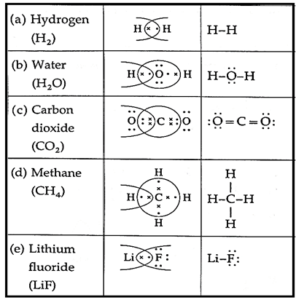
(B) Diagram for bonding in ethene with sp2 Hybridisation.

(C) Lewis electron dot structures of
(a) HF (b) C2H6 (c) C2H4 (d) CF3Cl (e) SO2
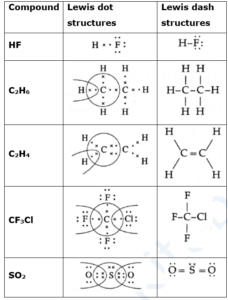
(D) Draw orbital diagrams of
(a) Fluorine molecule
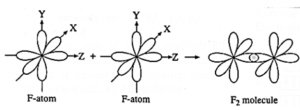
(b) Hydrogen fluoride molecule

Question 3.
Answer the following questions
(A) Distinguish between sigma and pi bond.
| Sigma bond | Pi bond |
| This is the covalent bond formed by coaxial overlap of two half filled atomic orbitals. | This is the covalent bond formed by side-wise overlap of two half filled atomic orbitals. |
| This overlapping is along the internuclear axis. | This overlap is around the internuclear axis. |
| The bond enthalpy of a bond is comparatively higher. | The bond enthalpy is comparatively lower. |
| The sigma bond is formed by the overlap of two ’s’ orbitals, one ‘s’ and one ‘p2’ orbital or two ‘p’ orbitals. | The pi bond is formed sidewise overlap of two ’p’ orbitals. |
(B) Display electron distribution around the oxygen atom in water molecule and state shape of the molecule, also write H-O-H bond angle.
- Electron distribution in H2O molecule

- Shape of H2O molecule : V Shape
- H—O—H bond angle : 104035’
(C) State octet rule. Explain its inadequacies with respect to
(a) Incomplete octet (b) Expanded octet
Octet rule states that during the formation of chemical bond, atom loses, gains or shares electrons so that its outermost orbit (valence shell) contains eight electrons. Therefore the atom attains the nearest inert gas electronic configuration.
(a) Incomplete Octet: Some atoms can form stable compounds even when they possess fewer than eight valence electrons in their outermost shell.
Examples : Beryllium (Be), and Boron (B).
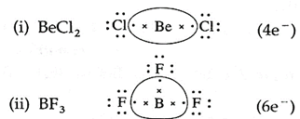
(b) Expanded Octet: Some molecules defy the octet rule by accommodating more than eight electrons around the central atom.
Examples :
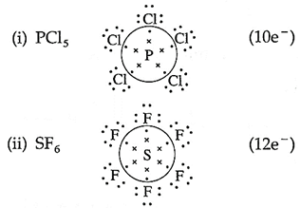
(D) Explain in brief with one example:
(a) Ionic bond
Ionic bond : This bond is formed by a transfer of one or more electrons from one atom to another forming cation and anion.
Example : NaCl.
![]()
(b) Covalent bond.
Covalent bond : A covalent bond is an attractive force formed by the mutual sharing of electrons between two atoms with similar or small differences in electronegativity. It is represented by a dash (—) between the two bonding atoms.
Example : Covalent bond formation in H2 molecule

(c) Co-ordinate bond.
Co-ordinate covalent bond : This bond is formed by sharing a pair of electrons from one atom by two bonding atoms. It is represented by an arrow from a donor atom to an acceptor atom.
Example : SO2

(E) Give reasons for need of Hybridisation
The concept of hybridisation was introduced by Pauling and Slater as a result of failure of valence bond theory to explain the following points.
(i) Valencies of certain elements : Valency of an element is equal to the number of unpaired electrons in the atoms. However, valency of certain elements cannot be explained on this basis.
For example :
- Beryllium has electronic configuration 1s2, 2s2. The expected valency is zero (as there is no unpaired electron) but the observed valency is 2 as in BeCl2.
- Boron has electronic configuration 1s2, 2s2 2px1. The valency should be 1 but it is 3 as in BF3.
- Carbon has electronic configuration 1s2, 2s2 2px1, 2py1 The valency should be 2 but observed valency is 4 as in CH4.
(ii) The shapes and geometry of certain molecules : The valence bond theory cannot explain shapes, geometry and bond angles in certain molecules.
For example :
- Tetrahedral shape of methane molecule.
- Bond angles in molecules like NH3 (107°18') and H2O (104°35’) molecules.
- But all these points can be explained only by the concept of hybridisation, which explains its need.
(F) Explain geometry of methane molecule on the basis of Hybridisation.
Geometry of methane molecule on the basis of sp3-hybridisation :
(i) Methane (CH4) molecule has one carbon atom and four hydrogen atoms.
(ii) Electronic configuration of H (= 1) : 1s2
C (=6) : 1s1, 2s2, 2px1, 2py1.
(iii) The central carbon atom undergoes sp3-hybridisation. Carbon is 1s1, 2s2, 2px1, 2py1 2pz0. In order to form four equivalent bonds with hydrogen the 2s and 2p orbitals undergo hybridization.
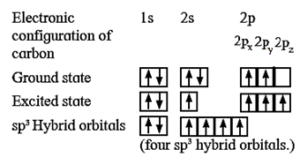
(iv) Tetravalency of carbon : In the ground state, carbon atom has only two unpaired electrons, hence, it should be divalent. But its tetravalency is explained by excitation of an electron from lower energy 2s—orbital to the higher energy vacant 2pz-orbital giving four unpaired electrons.
(v) sp3-Hybridisation : In this, one s-orbital and three p-orbitals of C atom undergo sp3-hybridisation forming four equivalent sp3-hybridised orbitals directed towards four corners of tetrahedron with the angle 109°28’.
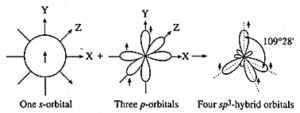
(vi) Formation of bonds : Each sp3-hybridised orbital of carbon atom overlaps coaxially with 1s-orbital of each hydrogen atom having unpaired electron with opposite spin forming four sp3-s sigma (σ) bonds.
- Therefore the geometry of methane molecule is tetrahedral.
- Each H—C—H bond angle is 109°28’.

(G) In Ammonia molecule the bond angle is 1070 and in water molecule it is 104035’, although in both the central atoms are sp3 hybridized Explain.
- In NH3 molecule, there are three bond pairs of 3 N—H bonds and one lone pair of electrons on N atom.
- In H2O molecule there are 2 O-H bond pairs and two lone pairs of electrons on oxygen atom.
- Due to greater repulsion between lone pair—lone pair and lone pair—bond pair in H2O than in NH3 molecule, the bond angle is reduced more in H2O than in NH3.
- Hence, the bond angle in NH3 is 107° and in H2O it is 104° 35’.
(H) Give reasons for:
(a) Sigma (σ)bond is stronger than Pi (π)bond.
- Sigma (σ) bond is formed by coaxial overlapping while pi (π) bond is formed by sidewise or colateral overlapping of atomic orbitals of bonding atoms.
- Hence the extent of overlapping in a sigma (σ) bond is greater than in pi (π) bond.
- The bond enthalpy of a sigma bond is higher than pi bond.
Therefore sigma bond is stronger than pi bond.
(b) HF is a polar molecule.
In HF molecule, fluorine being highly electronegative, there is a partial shift of electron bond pair towards F atom, making it partially negative and H atom partially positive. Hence HF is a polar molecule.
(c) Carbon is a tetravalent in nature.
Carbon has electronic configuration 6C 1s2 2s2 2p2 since it has four valence electrons it is tetravalent in nature.
(I) Which type of hybridization is present in ammonia molecule? Write the geometry and bond angle present in ammonia.
- Types of hybridization : sp3
- Geometry : Pyramidal
- Bond angle : 107°18’
(J) Identify the type of orbital overlap present in (a) H2 (b) F2 (c) H-F molecule. Explain diagrammatically.
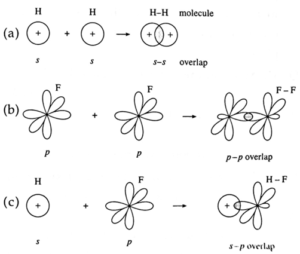
(K) F-Be-F is a liner molecule but H-O-H is angular. Explain.
In F—Be—F molecule, there is sp-hybridisation hence it is linear. But in H—O—H molecule, there is sp3-hybridisation and there are two lone pairs of electrons on oxygen, hence it is angular.
(L) BF3 molecule is planar but NH3 pyramidal. Explain.
BF3 molecule has sp2-hybridisation hence it is planar while NH3 molecule has sp3-hybridisation and N has a lone pair of electrons on oxygen, hence it is pyramidal.
(M) In case of bond formation in Acetylene molecule :
(a) How many covalend bonds are formed ?
(b) State number of sigma and pi bonds formed.
(c) Name the type of Hybridisation.
In case of acetylene molecule :
(a) Number of covalent bonds = 5
(b) Number of sigma bonds = 3, Number of pi bonds = 2
(c) Type of hybridisation = sp.
(N) Define :
(a) Bond Enthalpy
- It is the amount of energy (or enthalpy charge) required to break one mole of a particular bond present between two atoms in the gaseous state.
- Bond enthalpy of a diatomic molecule is equal to its dissociation energy.
- Bond enthalpy is a measure of strength of the bond between two atoms.
- Larger the bond dissociation energy stronger is the bond.
- In case of polyatomic molecules, the bond enthalpy is the average of the sum of successive bond dissociation energies.
Example :
H2O(g) → H(g) + OH(g) ΔH1 = 502 kJ mol-1
OH(g) → H(g) + O(g) ΔH2 = 427 kJ mol-1
Hence average bond enthalpy of O—H bond is
ΔH = (502 + 427)/2 = 464.5 kJ mol-1
(b) Bond Length.
- Bond length implies the equilibrium distance between the nuclei of two covalently bonded atoms in a molecule.
- Bond lengths are measured by X-ray and Electron diffraction techniques.
- Each atom of the bonded pair contributes to the bond length. Bond length depends upon the size of atoms and multiplicity of bonds.
- It increases with increase in size of atom and decreases with increase in multiplicity of bond.
- It is generally measured in picometre (pm) or in Angstrom unit (Å)
(O) Predict the shape and bond angles in the following molecules:
(a) CF4 (b) NF3 (c) HCN (d) H2S
| Molecules | Shape | Bond angles |
| CF4 | Tetrahedral | 109° 28 |
| NF3 | Pyramidal | 102° |
| HCN | Linear | 180° |
| H2S | V-shaped | 109.5° |
(4) Using data from the Table, answer the following :
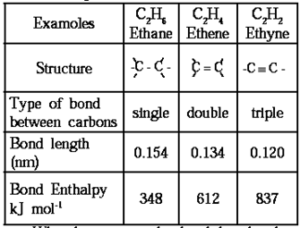
(a) What happens to the bond length when unsaturation increases?
(b) Which is the most stable compound?
(c) Indicate the relation between bond strength and Bond enthalpy.
(d) Comment on overall relation between Bond length, Bond Enthalpy and Bond strength and stability.
(a) As unsaturation increases, bond length decreases.
(b) Since ethyne has a triple bond (-C ≡ C-), the least bond length and the highest bond enthalpy, it is the most stable compound.
(c) As bond length decreases, bond enthalpy increases.
(d) As bond length decreases, bond enthalpy increases, bond strength increases and stability of the compound increases.
(5) Complete the flow chart


(6) Complete the following Table.
| Molecule | Type of Hybridisation | Type of bonds | Geometry | Bond angle |
| CH4 | 4C-H, 4σ bonds | Tetrahedral | ||
| NH3 | sp3 | 3N-H, 3σ bonds, 1 lone pair | ||
| H2O | angular | 104.50 | ||
| BF3 | sp2 | 1200 | ||
| C2H4 | 1200 | |||
| BeF2 | 2 Be-F | Linear | ||
| C2H2 | sp | (3σ+2π), 1C-C σ, 2C-H σ, 2C-C π |
| Molecule | Type of Hybridisation | Type of bonds | Geometry | Bond angle |
| CH4 | sp3 | 4C-H, 4σ bonds | Tetrahedral | 109028’ |
| NH3 | sp3 | 3N-H, 3σ bonds, 1 lone pair | Pyramidal | 107018’ |
| H2O | sp3 | 2O-H, 2σ bonds, 2 lone pairs | Angular | 104.50 |
| BF3 | sp2 | 3 B-F, 3σ bonds | Trigonal planar | 1200 |
| C2H4 | sp2 | 1 C-C, 4 C-H, 5σ , 1π bonds | Trigonal planar | 1200 |
| BeF2 | sp | 2 Be-F | Linear | 1800 |
| C2H2 | sp | (3σ+2π), 1C-C σ, 2C-H σ, 2C-C π |
Linear |
1200 |
(7) Answer in one sentence:
(A) Indicate the factor on which stability of ionic compound is measured?
The stability of ionic compound depends upon :
(i) size of cation and anion
(ii) charge on ions
(iii) lattice energy.
(B) Arrange the following compounds on the basis of lattice energies in decreasing (descending) order: BeF2, AlCl3, LiCl, CaCl2, NaCl
Decreasing order of lattice energies :
| Molecule | AlCl3 > BeF2 > CaCl2 >LiCl >NaCl |
| Lattice energy in kJ mol-1 | 5492 3020 2258 853 788 |
(C) Give the total number of electrons around sulphur (S) in SF6 compound.
There are six S-F covalent bonds, hence there are six bond pairs and 12 electrons around S in SF6.
(D) Covalant bond is directional in nature. Justify.
A covalent bond is formed by co-axial over-lapping of atomic orbitals like s-s, p-p and s-p. Hence it is directional.
(E) What are the interacting forces present during formation of a molecule of a compound ?
The interacting forces present during the formation of a molecule are :
- Attractive forces between electrons of atom A and nucleus of atom B.
- Repulsive forces between electrons of A and B as well as repulsive forces between nuclei of A and B.
(F) Give the type of overlap by which pi (π) bond is formed.
Pi (π) bond is formed by colateral or sidewise overlap of p-orbitals of two bonding atoms.
(G) Mention the steps involved in Hybridization.
Following steps are involved in hybridisation :
(i) Formation of an excited state.
(ii) Mixing and recasting of atomic orbitals.
(iii) Orientation of hybrid orbitals in space.
(iv) Conditions for hybridisation.
(H) Write the formula to calculate bond order of molecule.
Bond order = \(\frac{N_b-N_a}{2}\)
where Nb and Na are number of electrons present in bonding and antibonding molecular orbitals respectively.
(I) Why is O2 molecule paramagnetic?
Since O2 has two unpaired electrons in two antibonding molecular orbitals (π*2p'y and π *2p'z), it is paramagnetic in nature.
(J) What do you mean by formal charge ? Explain its significance with the help of suitable example.
Formal charge : The formal charge of an atom in a polyatomic molecule or an ion is defined as the difference between the number of valence electrons of the atom in an isolated or a free state and the number of electrons assigned to that atom in the Lewis structure.
Significance of formal charge :
- It helps us in assigning bonds when several structures for the given compound are
- The best Lewis structure is chosen such that the formal charge is as close to zero as possible.
- The structure having the lowest formal charge has the lowest energy and hence the highest stability.
Main Page : – Maharashtra Board Class 11th-Chemistry – All chapters notes, solutions, videos, test, pdf.
Previous Chapter : Chapter-4-Structure of Atom – Online Solution
Next Chapter : Chapter-6-Redox Reactions – Online Solution
We reply to valid query.